By Dave McCracken
Part One – The Fundamentals
During the Group Mining Projects we conduct each season, I always like to start by discussing the most important and fundamental ingredient in successful gold mining. That basic ingredient is you, yourself!
You are the one who makes decisions for yourself. You decided to get into mining in the first place. You also make the decisions on how you are going to approach gold mining, and how you are going to deal with all of the problems and the barriers to your success. Regardless of suggestions or input you receive from others, you make the final decisions on what you are going to do-no matter what they are.
The main problem in gold mining is in overcoming unknowns. Until you find them, you do not usually know where the good gold deposits are located. If it were really easy, all the gold would already be gone. The fact that so much gold is being recovered by small-scale miners today proves it was not easy to find in the first place. Otherwise, the old-timers would have found it all!
 True, it is much easier for us now than it was for them. We have low-cost modern equipment they never even dreamed of! Accessibility to gold-bearing areas is excellent. We have new technology as well as the benefit of the technology developed by the old-timers. We also have historical information that directs us to the proven gold-bearing locations. The old-timers had it much more difficult than we do. But, it is still not that easy. When you get out into the field, you are mainly faced with not knowing where the gold is! And, this is where it comes down to you and your ability to overcome problems and the unknown.
True, it is much easier for us now than it was for them. We have low-cost modern equipment they never even dreamed of! Accessibility to gold-bearing areas is excellent. We have new technology as well as the benefit of the technology developed by the old-timers. We also have historical information that directs us to the proven gold-bearing locations. The old-timers had it much more difficult than we do. But, it is still not that easy. When you get out into the field, you are mainly faced with not knowing where the gold is! And, this is where it comes down to you and your ability to overcome problems and the unknown.
Gold mining procedure is very simple. And there is an enormous amount of gold still accessible to the small-scale miner. The problem you face is not knowing exactly where it is. It can be six inches beneath where you’re standing or where you are digging, and you will have no idea it is there for sure until you find it!
You live by every decision you make. If you decide in your own mind there is no gold in an area or on a claim, you are probably not going to prospect that area, unless you change your mind. It is important to avoid making decisions that are not based upon solid observation. A miner on any scale must be an investigator, a hound dog on a tricky trail. Good investigators never rule out possibilities before their time.
Successful gold mining is generally done in two steps: First is sampling or prospecting, and then, production.
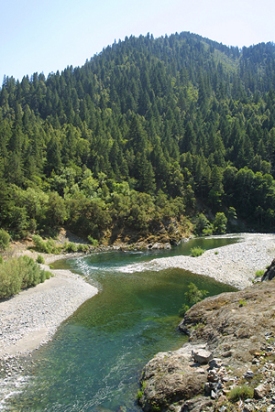 While some gold-bearing creeks and rivers tend to have gold values dispersed throughout their entire streambeds, there is generally not enough gold to make a small-scale mining operation payoff very well. Because we are limited as to how much gravel we can process as small-scale miners, we need to find higher-grade deposits. This means we need to look for them, and this is where sampling comes in.
While some gold-bearing creeks and rivers tend to have gold values dispersed throughout their entire streambeds, there is generally not enough gold to make a small-scale mining operation payoff very well. Because we are limited as to how much gravel we can process as small-scale miners, we need to find higher-grade deposits. This means we need to look for them, and this is where sampling comes in.
When my partners and I first started gold dredging, we made the mistake of putting our dredge into a likely spot and dredging in that same location for about 30 days, even though we were not getting very much gold. We had in our minds that we had to keep going because we just might uncover a bonanza at any time. While that may have been possible, we would have had to be very lucky to find a rich deposit this way.
Because gold is so heavy — about six times heavier than other average materials found in a streambed, such as rock, sand and silt –it tends to follow a certain path when being moved in a river. This path generally runs from inside bend to inside bend (when the waterway is running at flood stage), and in a meandering line between the bends. Gold deposits are sometimes found elsewhere, but the statistics of history show that most recovered deposits have been located along these paths.
This is a very important bit of information; it provides you with a good idea of where to start your sampling. You can rule out about 90% of the riverbed at the start, and concentrate your sampling efforts along the path where you are most likely to locate an acceptable gold deposit.
Let’s define a few basics: “Bedrock” is the solid hard rock of the earth’s crust–like a cliff or like the solid rock you see in highway road-cuts through the mountains. “Streambed” consists of all of the rocks, sand, silt, gold, and other sediments that end up in the bottom of a creek or river. Streambed always lies on top of bedrock. A “lode” gold deposit is gold that is still locked up in solid rock, often contained in quartz veins. “Placer” gold deposits are created after erosion has broken the gold away from the lode and deposited it elsewhere. There are different kinds of placer deposits. The difference primarily has to do with how far away from the original lode the gold has traveled.
Hidden irregularities on the bedrock channel of a river can change where the gold path runs. So, until you locate the gold path, you are never certain where it is going to be. But inside bend to inside bend (during flood stage), and a meandering line between inside bends, is a good place to start your sampling. I have seen some gold paths located off this line, so you have to be flexible. But this is what sampling is all about. Sampling is done by digging or dredging test holes in different locations, comparing one against the next, establishing where the better results are coming from, and following those positive signs until you locate an acceptable deposit.
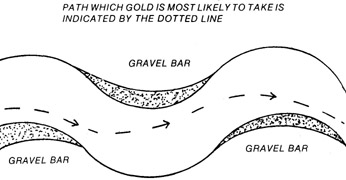
Most gold-bearing rivers have a certain amount of low-grade gold values dispersed throughout the gravel. The general gold path tends to have more gold along it than the average gravel throughout the rest of the river. You also generally find more iron and other heavy elements along the gold path.
When making test holes, keep track of the amount of iron, iron objects, and gold that you recover from each hole. After you have completed a number of holes, you will start to get an idea of the average gold values and other heavy materials in the riverbed. Then, when you turn up more than the average amount in a test hole, it is a sign that you have located the gold path. Sometimes, there is little visible increase in gold, but there is a visible increase in the amount of iron rocks, pieces of lead, and old rusty objects.
There is a certain amount of microscopic-sized gold moving downstream in some rivers at all times. However, gold that is large enough for us to recover with our small-scale mining equipment generally does not move in a riverbed to a large extent, except during major flood storms. Storms of this magnitude are able to generate enough water force and turbulence to get all or most of the streambed material flowing down the riverbed along with the water.
Because gold is so heavy, when being washed downstream, it quickly works its way to the bottom of the other materials being washed along with it. The gold also moves more slowly. Cracks, crevices, holes and barriers in the bedrock can trap the gold out of the flow of water and material. And of course, this happens much more along the general gold path than off of it.
Gold deposits along the general gold path can be small or large, depending upon the size of the gold trap. The most important type of gold trap in river mining is called the “pay-streak”. Pay-streaks always form along the gold path where the river’s flow slows down on a large scale during a major flood storm. One example is the tail end of an inside bend in a river. Centrifugal force places most of the water pressure to the outside of the bend, leaving a low-pressure (low-velocity) area at the tail end of the inside bend. This is a very common location in gold-bearing rivers to find pay-streaks.
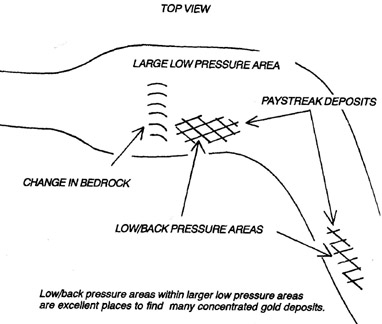
Another example is where the river slows down after a long stretch of faster water. Anywhere along the general gold path where the river slows down on a large scale during a major flood storm is a likely spot to find pay-streaks.
Pay-streaks are important because they are large deposits as opposed to smaller, single-type deposits–like what you might find in a bedrock crevice along the general gold path. The size and richness of a pay-streak depends upon the size of the low-pressure (low-velocity) area created in the river, and on how much gold traveled through that section of the river during the flood storms which formed the deposit.
Most pay-streaks have definite left and right outside boundaries, meaning the gold tends to run out quickly once you get outside the pay-streak. Sometimes upstream and downstream boundaries are not so easy to distinguish. Varying water flow turbulence during major storms can sometimes make a pay-streak somewhat inconsistent. It may appear to be good for a while, bad for a while, and then good again, but the outside left and right boundaries tend to hold true most of the time.
Because pay-streaks have some size to them, they are much easier to find than single-type deposits while sampling. Most successful river miners use the following technique to locate and recover pay-streaks: First, locate a proven gold producing section of the river. By digging or dredging sample holes, locate the main gold path. More sample holes are continued along the path until a pay-streak is located.
This method is generally used whether the operation uses gold dredges in the river, sluices, or even heavy equipment up on the bank. Since the bank consists of older streambeds left high and dry, you are just as likely to find pay-streaks on the bank, or in the ancient streambeds further away, as you are in the river itself. If you are able to find acceptable amounts of gold in a riverbed and you want to find more, look upstream and downstream along the same line of flow in the riverbed. Keep in mind the direction water and material would be moving in a major storm. Gold generally will have moved in the same direction as the water flow.
The point about locating a proven gold-producing section of river is really important! You can save yourself a lot of time and energy by finding out where other miners are already doing well. If somebody has located a pay-streak, there will almost always be more pay-streaks in that general area of the river.
Investigation to locate proven areas, and communication with local successful miners to find out where deposits have been located, can save a great deal of sampling time. All of the really successful small-scale miners I know make it their business to stay updated on who is finding deposits and where.
The overall process of successful mining is quite simple. We have it down to a science, having taken most of the chance out of it. Gold travels and deposits along special lines. A knowledgeable, energetic, persistent sampling effort is assured of always finding the next pay-streak.
Sound simple? It isn’t that easy! This is because you never know where the next deposit is or how long it is going to take to find it. And, this is why it always comes back down to that important, fundamental ingredient, which is you!
You are the one who decides where to put your sample holes, how large to make them, and how long to continue them. You are also the one who evaluates the test results and has to decide what to do next. You have to decide, based upon your sampling results and the other information you have collected, whether a certain section of river deserves further sampling activity or if you should move on to another location. Every decision you make is a crossroads that will directly affect the final outcome.
It is important to realize that how much gold you get from your mining activity depends entirely on you and what you decide to do. A good miner is an investigator who tracks down where the gold is coming from, and diligently works his or her way right into it. How good you are does not depend upon how much time you have spent at it in the past. It depends upon how much you really want to succeed and how willing you are to hustle yourself into a deposit.
I know of quite a few people who have discovered rich gold deposits in their first season. I also know a lot of guys who have been at it for years, and still cannot seem to find acceptable deposits for themselves. Why is this? They are not sticking to the right procedure. They are making the wrong decisions, and, a lot of the time, they are (deciding to) giving up too easily.
Again, the main problem is not knowing. So, based on the information you do have, you are constantly being put to the test, having to decide if the gold is likely to be in a certain area or if it is more likely not to be.
People who have the most trouble in gold mining are the ones who give up too easily. You need to give your sample holes a little more time and effort than they deserve, but without overdoing it. This is a matter of judgment which gets a little easier with experience. It’s always going to be a challenge, though; because you don’t know if the gold is going to be there right up until the point when you find it!
Once you find a good deposit, it is easy to see why it is located there, and you will also see how easy it was to find. But when it runs out, you are right back to not knowing where the next one is going to be. Gold mining is always an emotional challenge.
The problem most people have with mining and sampling has little to do with judgment in sampling. It has to do with other basic decisions they have already made concerning their own personal success. It is very difficult to help someone become a successful miner when that person has already decided he or she is not going to do very well at it. Some people work at it just a little bit, and then give up on their sample holes long before they are completed. You cannot find gold deposits this way unless you are awfully lucky. This is good food for thought for everyone.
Some people get into gold mining as a get-rich-quick solution to other problems they have created in their lives. Any person who is giving up or quitting in their personal life hasn’t much chance of succeeding at gold mining!
If you are not finding enough gold, you cannot blame the claim, the river, the club you belong to, or anything else. Blaming an outside source might make your ego feel better, but it will not help you locate more gold. You are either getting it, or you are not. Blaming anyone or anything else is going in the wrong direction. The answer is to become effective, communicate with other miners to find out where the gold is coming from, and then get busy with your sampling. If you want to do well in gold mining, you have to make it happen!
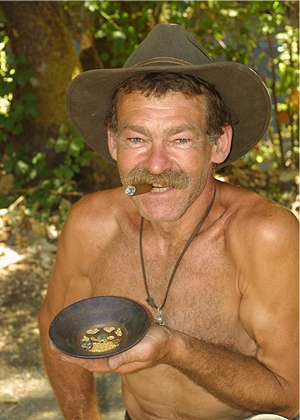 And, if you are not sure if you have given a sample hole everything it deserves, be honest with yourself about it and give it a little more. It takes personal discipline to be a good sampler!
And, if you are not sure if you have given a sample hole everything it deserves, be honest with yourself about it and give it a little more. It takes personal discipline to be a good sampler!
This is not to say that gold mining cannot be fun. It is a great outdoor activity no matter how much gold you find while you are prospecting for high-grade deposits. Once you get involved though, you will find it is more fun if you are finding more gold! If you are looking for challenge in your life, if you want to put yourself to the real test, then gold mining is just the thing for you!
When you are producing sample holes and not finding acceptable amounts of gold, when you are not sure where the gold might be, and you are not sure exactly how to deal with it, that is when you are put to the real personal test. This is when you have the opportunity to see who you really are and where your personal improvement lies. There is not a successful miner alive who does not have to deal with this on a continuing basis! This is why it always comes back to you. If you are strong enough to pull yourself through it, you will learn to sample, enjoy new thrills, and attain personal achievement and growth, not to mention the gold you will find.
There is much, much more to know about the business of sampling, which we will continue to cover in future articles. But we have covered the most important and fundamental ingredient here. If you can get yourself squared away with the right attitude, and approach mining with a stiff upper lip and the eye of a tiger, you will have no trouble figuring out the rest!
Don’t quit!
- Here is where you can buy a sample of natural gold.
- Here is where you can buy Gold Prospecting Equipment & Supplies.
- More About Gold Prospecting
- More Gold Mining Adventures
- Schedule of Events
- Best-selling Books & DVD’s on this Subject





